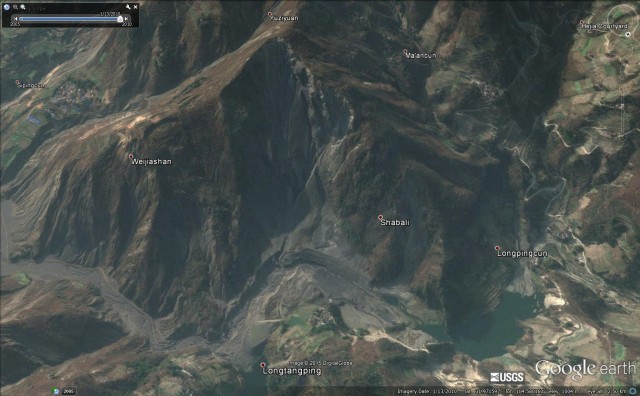11 January 2016
The weirdness of Mass Ejection Landslides in China
Posted by Dave Petley
Mass Ejection Landslides
A paper (Tang et al. 2015) has recently been published in a Special Issue of the reputable journal Engineering Geology that considers mechanisms of a high energy, long run out landslide type that occurred in the 2008 Wenchuan Earthquake in China. These mass movements are termed Mass Ejection Landslides. In the paper these landslides, fully termed “mass ejection type of high-speed and long-run-out” (ME-HSLR) landslide are described as follows:
“This type of landslide is characterized by concealed development, sudden break-out, dramatic ejection of landslide material through the air, and devastating consequences … Therefore, in a general sense this type of ME-HSLR landslide can be also described as rock avalanches with the feature of becoming airborne”
Chinese authors have described six of these mass ejection landslides in the Wenchuan earthquake, although the vast majority of the papers are in Chinese. Now, there are two weird things about these landslides. First, as described in the literature these landslides were literally ejected from the ground to fly with a ballistic trajectory through the air before running out. And second, as far as I am aware these landslides have never been described anywhere else.
Now, if the paper by Tang et al. (2015) (there is a PDF of this paper online here) is correct, these landslides are truly miraculous. The “take-off” velocities for the mass ejection range from 25 m/sec for the enormous Daguangbao landslide to 75 m/sec for the Jingu landslide. Most are 70 m/sec or more. To put that into context, 70 m/sec is about 250 km/hr. That is seriously fast! And remember that this is not something that happens down the landslide track, or at the bottom of a near vertical slope, this is how the landslide leaves the source area. As Tang et al. (2015) put it:
“In this paper, the term “take-off speed” is exactly the speed when the landslide mass has moved a considerable distance and reaches the “ski jump”, and at this speed, the slope mass is torn out from the mother body.”
So the argument goes that these landslides area able to reach velocities of 250 km/h from a standing start as they depart the source area.
Tang et al. (2015) illustrate their paper with the Jingu landslide, which had a volume of about 2 million cubic metres. This landslide can be seen in the Google Earth imagery of the area, taken in 2010:
.
This is clearly a large and mobile landslide, but there is nothing in the image that I can see that suggests it had an initial airborne component. In their paper, Tang et al. (2015) describe it thus:
“During the earthquake, the slope mass of the upper throwing depletion zone was sheared and torn from the main body of the landslide, and the huge mass was launched from the location of the upper and lower boundary. After flying several hundred meters, the ejected mass seriously impacted the area across the river, and formed a huge area of debris splash.”
The justification for this interpretation, as far as I can understand it, is that the landslide deposit was thick on the far side of the river from the landslide (towards the foot of the slope in the image above) than closer to the source, and that after the landslide there was little evidence that the river had been blocked for long. This is said to infer that the landslide mass must have flown across the river to end as a pile on the far side.
I am afraid that I am somewhat doubtful of this. The behaviour seems too extreme, the velocities so high, and the mechanism so exotic that I think there must be a simpler explanation., It is true that landslides can reach very high velocities, but usually only after descending steep slopes, often with very low friction conditions being established. To me a much simpler explanation is that the landslide failed conventionally, descended the lower (steep) slope conventionally, achieving a high velocity. The mass then travelled across the valley with almost no deposition before striking the opposite valley wall and stopping. Thus, it left little material in the river.
This is a much simpler mechanism that seems to fit all of the known facts without requiring extraordinary processes that have not been described elsewhere, Thus, to be honest, I remain to be convinced that Mass Ejection landslides are a real phenomena.
I welcome the thoughts of others.
Reference
Tang, H-M., Liu, X, Hu, X-L. and Griffiths, D.V. 2015. Evaluation of landslide mechanisms characterized by high-speed mass ejection and long-run-out based on events following the Wenchuan earthquake, Engineering Geology, 194, 12-24. (available online here).



 Dave Petley is the Vice-Chancellor of the University of Hull in the United Kingdom. His blog provides commentary and analysis of landslide events occurring worldwide, including the landslides themselves, latest research, and conferences and meetings.
Dave Petley is the Vice-Chancellor of the University of Hull in the United Kingdom. His blog provides commentary and analysis of landslide events occurring worldwide, including the landslides themselves, latest research, and conferences and meetings.